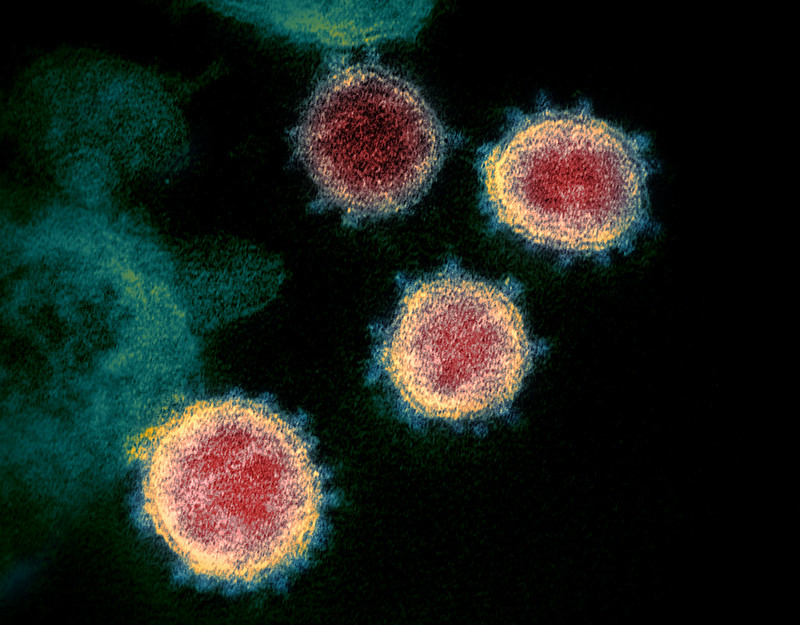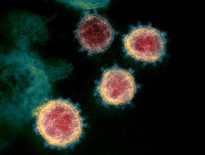
Credit: National Institutes of Health / flickr
Unless you’ve been strictly limiting your media consumption to reviews of the midseason finale of The Walking Dead, you’ve probably heard of a novel coronavirus that is causing a bit of bother among public health officials. In this post I’ll try to summarize and explain the evolving situation and highlight the current advice for the US public.
In December, a coronavirus that had never before been detected in humans began making people sick in Wuhan City, China. Since that time according to the World Health Organization, this novel virus has caused about 83,000 people to be sick and has caused 2,858 deaths. Almost all the deaths have been in China. The illness has now been identified in 52 countries. There have been 15 confirmed cases in the US, 12 of which related to international travel. The first death in the US was just reported.
This novel coronavirus (The virus’s official name is “SARS-CoV-2”, which is a terrible name. As soon as it turns 18 it should legally change its name to something simple, like Fred.) typically causes cough, fever and shortness of breath. But in some people these symptoms are very mild, and it’s likely that some infected people never develop any symptoms. (This is an important fact that we’ll return to.) The fatalities have been disproportionately older patients and patients with other medical problems. There have been virtually no children or young adults among the fatalities.
First, let’s take a step back to ask what’s the big deal? There are lots of existing viruses that cause fever, cough, and shortness of breath, like the influenza virus and all the viruses that cause colds. Influenza kills lots of people every year. Why the big fuss over the novel coronavirus / SARS-CoV-2 / Fred?
There are two answers. The first is that the novel virus might be more dangerous than other typical respiratory viruses. The CDC estimates that the US has tens of millions of influenza cases annually, causing tens of thousands of deaths. That works out to 1 to 2 deaths per thousand cases. So far, the fatality rate (the number of deaths divided by the total number of cases) for the illness caused by SARS-CoV-2 is about 3%. That’s about 20 times higher than the fatality rate of the flu. (By the way, the official name for the disease caused by this new virus is “coronavirus disease 2019” which is abbreviated COVID-19. The jargon might kill us before the pandemic.) That comparison very likely overestimates the severity of COVID-19, because it likely doesn’t count a very large number of cases that were asymptomatic and never came to medical attention. So the actual fatality rate of COVID-19 is likely smaller, but let’s assume that it’s higher than the flu.
The more important reason why new viruses in humans scare public health officials is because the entire human population is susceptible. Viruses (like flus and colds) that have been circulating for centuries constantly mutate to produce new strains, but lots of people recently infected with similar strains are partially immune. So as a new strain spreads through a population, it encounters some individuals who can’t get infected or who have only a very brief illness because they were recently infected by a close cousin of the current virus. That slows the virus’s rate of spread and limits the number of vulnerable people. An analogy is the effect of occasional brush fires in large forests. The brush fire might burn an acre or two, but it clears out lots of fuel and limits the damage that the next fire can do. Occasional small fires prevent any one fire from doing very much damage.
An entirely new (to humans) virus is faced with a worldwide vulnerable human population, since no one has immunity to it. That’s like a single match in a forest that hasn’t had a brush fire in a century. The major problem to public health isn’t that the new coronavirus might kill 3% of those it infects, it’s that it might make 10,000 people sick in LA during one week. Not only would this overwhelm our ability to care for coronavirus patients, but anyone with a stroke or heart attack that week would be unable to receive prompt care. Problems that grow exponentially swamp our resources. We can take care of tens of thousands of flu cases when they spread out over the whole flu season. We couldn’t do it if they all got sick at the same time.
So what should we do? Is it time to cower under our desks? Not yet. Is there a vaccine? Not yet. Is it time to take all the cipro you’ve been stockpiling since the 2001 anthrax scare? No. Antibiotics kill bacteria. They don’t affect viruses. Should we stockpile Tamiflu? Current antiviral medicines like Tamiflu don’t work on coronaviruses, unfortunately.
First, if you are planning to travel, keep an eye on the Centers for Disease Control Coronavirus Travel page. The global situation is evolving rapidly, and various regions have different levels of health notices to travelers. If the CDC recommends against travel somewhere, don’t go there.
Second, follow the CDC’s commonsense suggestions for avoiding getting sick. Wash your hands frequently. Stay home when you are sick. Cover your cough or sneeze with a tissue. And don’t bother stocking up on facemasks.
If you get sick with a fever and respiratory symptoms like cough or shortness of breath within 14 days of travel to an area with COVID-19, stay home other than to get medical care. Call your healthcare professional prior to arriving to let them know about your symptoms and travel history.
Finally, as of this writing there is NOT any community spread of COVID-19 in Southern California. But if in the future there is community spread of COVID-19 in Los Angeles, then be prepared for the possible cancellation of public gatherings, such as schools, non-essential work, and public events. You should have at least several days of food, water and any prescription medications on hand and be prepared to stay in your home. But that’s not a new suggestion, since we live in earthquake country.
So take a deep breath, wash your hands, and keep an eye on the CDC page. We’ll get through this.
Learn more:
Coronavirus disease 2019 (COVID-19) Situation Report – 39 (World Health Organization)
First Coronavirus Death Reported in U.S. (Wall Street Journal)
What We Know About the Coronavirus, From Symptoms to Who Is at Risk (Wall Street Journal)
Coronavirus Disease 2019 Information for Travel (Centers for Disease Control and Prevention)
Coronavirus Disease 2019 Prevention & Treatment (Centers for Disease Control and Prevention)
Coronavirus Disease 2019 What to Do if You are Sick (Centers for Disease Control and Prevention)
Emergency Supplies for Earthquake Preparedness (Centers for Disease Control and Prevention)
My previous posts on potentially apocalyptic pathogens:
Zika Virus Gains A Foothold In Florida
Swine Flu: Unlikely To End The World
Why Ebola Is Not A Major Threat In The US
Contagion: The Reality Behind The Movie

